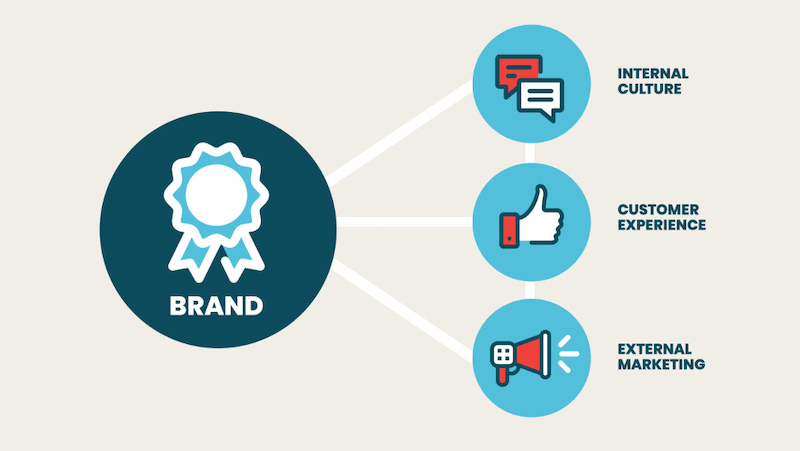10 Simple Steps to a Winning Brand Strategy
In reality, your brand encompasses all the things that make you stand out from competitors as different. Everything from your visual identity to your messaging to customer experience. Not to mention the way people perceive your business, including all of the thoughts and emotions they associate with your brand.
Because branding is so extensive, developing a strategy that works takes both time and careful planning. To help with that planning, consider some guidelines for creating an effective brand strategy for your business.
Elements of a strong brand strategy
Brand voice, brand design, brand values, brand story, and brand vibe are the key elements of a successful brand strategy. Below, we’ll walk you through each one, describe what it is, and look at why each bolsters the experience your brand creates for new and existing customers.
Brand story
Brand stories further spark connection between your business and customer base. By sharing why you exist, what you stand for, and what inspired you to get started and keep going, you create an open environment where people can get to know your business on a deeper level.
How Fly by Jing tells its brand story on its website
Its brand story takes center stage on its website, sharing why founder Jing Gao started the company: inspiration from the flavors and “fly restaurants” of Chengdu, her hometown. Fly By Jing’s website shares the brand’s values, like “power to empower,” taking a stance on why it believes its products are so important.
Finally, Jing notes that the flavors of each item share her own story, intertwining a narrative with the actual product experience. Not only does this entice a new customer to buy it, it nods to the care that goes into each product.
The core of Fly by Jing’s brand story. Fly by Jing
Brand voice
A brand’s voice informs the type of brand messaging a business uses. It often plays the biggest role in forming connections with a customer base by fusing a brand’s personality with its core values. A strong brand voice might remind you of your sarcastic best friend, kind teacher, or reassuring doctor. It sets the tone for the relationship that a customer will build with a brand over time and shows them what they can expect from it. A brand that doesn’t carve out a personality-filled voice risks losing that connection or sending a different message than it truly wants to.
How Sun Bum captures its brand stance via brand voice
A sunscreen business that originated in Cocoa Beach, Florida, Sun Bum is as much a community of those who “live and love in the sun” as it is a line of sun, hair, and skin care. Sun Bun’s brand voice underscores its laid-back and active ethos with taglines like “Work Less Live More,” balancing this friendly tone of voice with important messaging around sun protection.
Brand design
How your business shows up visually—from color palette to fonts to photography style—on your products, website, and marketing platforms is called brand design, and it’s often the first and quickest way a potential customer within your target market can understand what you’re all about.
Great brand design can be communicated via a sunscreen bottle with chic packaging, a bright label easily recognized at the grocery store, or fun shapes and elements on a website. Aside from speaking to what your brand is all about, brand design also illustrates a point of view and taste level. A potential customer might love your brand partly because of the way you package and design your products, or because of the colorful templates you send out with an email newsletter. Like art, brand design can draw an emotional response. Andy Warhol famously turned one brand’s packaging into pop art when he painted an array of Campbell’s soup cans.
A lack of design can leave your brand without a visual identity, which prospective customers will pick up on. Designing the visual components of your brand—from product labels to packaging inserts to your homepage—gives it a stronger position in the market, can improve customer experience, creates a strong visual identity, and can help differentiate you from your competitors.
Elements of brand design should also appear in a brand style guide alongside tone of voice specifications. As it pertains to a visual identity, this includes color hex codes, font weights and styles, logo usage, and more.
How Acid League and Salt & Stone capture different moods with brand design
A self-proclaimed “instant pantry makeover,” Acid League’s living vinegars and other acid-forward essentials bring a contemporary aesthetic to everyday kitchen condiments. Its bright, punchy labels mirror the bold flavors the brand infuses into its gut-healthy product line.
A vinegar kit by Acid League. Acid League
Acid League is on a mission to revive acid: “We started by reimagining vinegar, creating living vinegars with both bold flavors and good gut health benefits,” the shop says on its website.
Brand vibe
A brand’s vibe is the general sentiment it emits on its website, social media channels, product packaging, etc. The vibe could be anything from playful to sarcastic to serious to funny, and is an amalgamation of the ways a brand’s personality, values, and aesthetic line up.
If you’ve ever been to Palm Springs, or a craft coffee shop, you can sense a certain feeling or energy the moment you arrive. While many businesses operate online these days, it’s still possible to inject a specific vibe into the way someone feels when they interact with yours.
How Baggu captures a real vibe
Baggu sells all sorts of colorful printed bags, from foldable grocery totes to lunchbox-sized coolers. Its website is playful and funky, and it isn’t afraid to have fun with the marketing copy throughout. Puns and fun language like “Keep those socks from floating off into the ether” keep things light.
Phase 2: Brand Identity
1. Define your core brand identity
To remind you, your core brand identity is often defined by your company’s vision (why your company exists), mission (what your company does), and values (the beliefs that guide your company’s actions).
If you have an existing company, you evaluated your core brand identity in the discovery phase (Phase 1). You now have a chance to evolve that identity to better match your current/future vision, mission, and values.
2. Articulate your brand positioning
3. Articulate your unique selling proposition
Figuring out your USP can take time, but it’s a crucial piece of your brand and value proposition. Knowing what it is can help you sell better to your existing and prospective customers.
That’s because when customers hear your brand name, see your logo, view your business card, or see other elements of your brand identity, they’ll subconsciously connect your USP to your brand.
And be careful not to adopt the USP of a competitor. Don’t try to imitate others – build a unique identity and value proposition based on your customers’ feedback. Small business expert Ramon Ray explains:
Don’t try to be someone else. it’s tempting to look at another person or business and imitate them. This isn’t a good strategy. Instead, listen to your customers. What do they say they like about your business? What would they change? But don’t just listen to what your customer says … be sure your team communicates and meets your customers’ expectations through your brand identity and overall design so that your clients and prospects know you’re listening to them.
4. Develop your brand identity design assets
When you understand your brand and the components that define brand identity (colors, typography, shapes, etc.), it’s time for you to work with your graphic designer to develop the creative elements that will help you build a brand and give life to your brand identity. These include your logo, website design, product packaging, brochures, and more. We cover these issues in detail in our definitive brand identity guide.
5. Develop your brand voice and how you communicate
Can marketing psychology help you increase revenues?
Smart marketers incorporate one or more psychological principles into marketing campaigns, content marketing, and sales strategy. Here is everything you need to know about the important principles and theories that can supercharge your marketing and influence people to buy your products or services.
Phase 3: Execution
Once you’ve completed the discovery and developed your core brand identity, you must find the right way to communicate your brand identity and brand through marketing (digital marketing and traditional marketing).
1. Does your branding support your business strategy?
If your strategy is to sell expensive services at discounted rates, your brand should focus on price. It would not be in your best interest to cultivate a brand that appears affluent or expensive.
2. Is your brand identity consistent?
If your brand identity constantly changes, it’s hard for customers or clients to wrap their minds around what it’s about. And it’s even harder to gain trust, confidence, and brand loyalty.
Is your brand identity design visually consistent?
The colors, visual styles, and fonts on your website should look like your business cards, which should look like your social media accounts, which should look like your company logo, which should look like you.
Is your brand messaging consistent?
Does your brand behave consistently?
A fabulous logo, expertly deployed and a consistent style guide mean nothing if your business does not follow through on its brand promises in the real world. Remember that your brand should always be true to the reality of your business. Walking the walk is just as important, if not more so, than talking the talk.
Execute a quick Google search for “chipotle admits to using GMOs,” and you’ll find a list of critical articles and lawsuits levied against the fast-food mega-chain. They’ve hit on a compelling branding position, but they’re failing to deliver it reliably. Their brand image has suffered.
3. Does your brand identity resonate with your target audience?
No matter how well your brand identity supports your business strategies or how consistent it is, your brand identity is not doing its job if it fails to connect with your audience.
But, measuring your brand’s public reception is a bit trickier than examining it for consistency or internal strategy alignment. You’re going to need some brand health metrics to track.
Sources:
https://www.wordstream.com/blog/ws/2021/02/01/brand-strategy
https://www.shopify.com/blog/brand-strategy
https://www.crowdspring.com/blog/brand-strategy/






